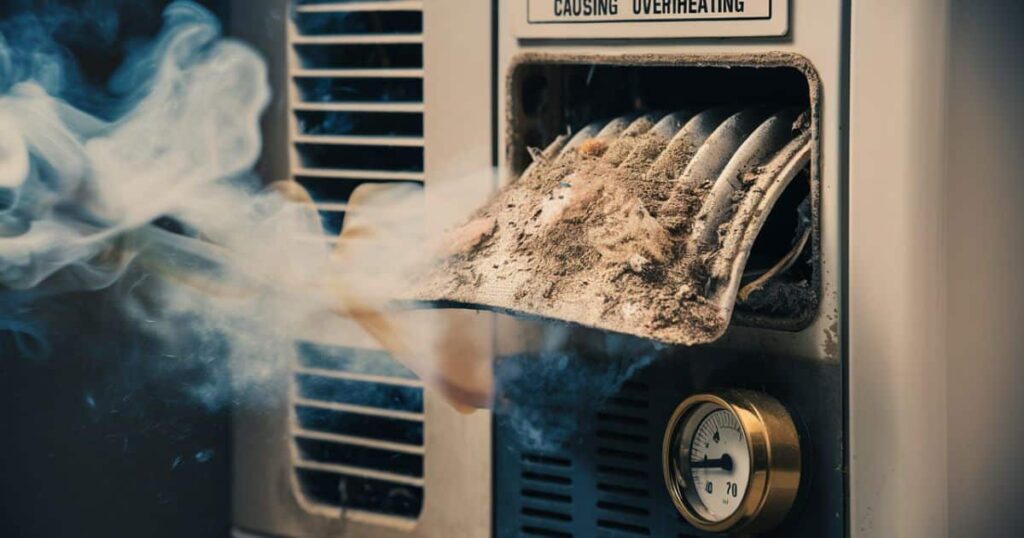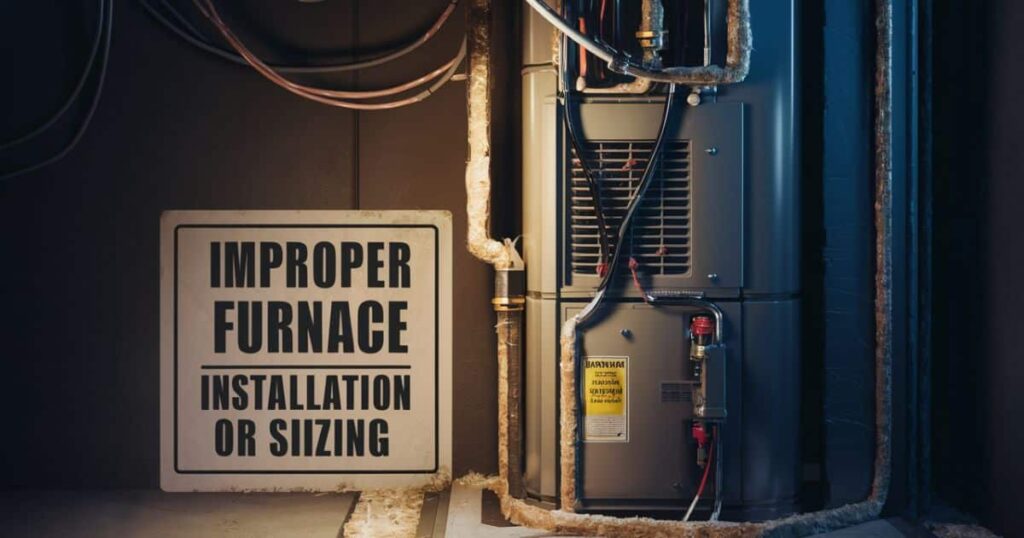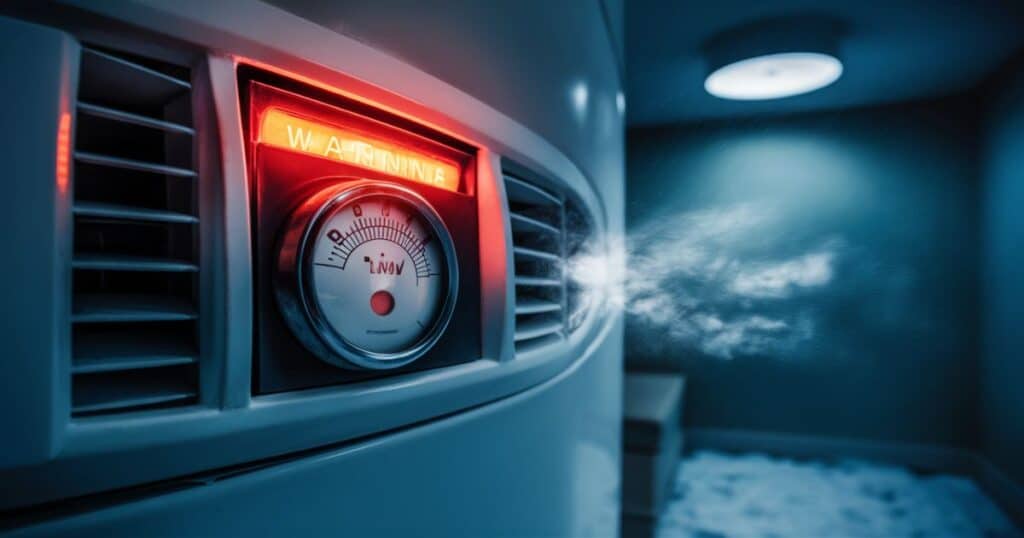There’s nothing worse than being left in the cold when your furnace keeps shutting off before it can properly heat your home.
While a cycling furnace can sometimes signal a serious problem, many times the issue has a fairly simple explanation and an easy DIY fix. Let’s explore some of the most common reasons why furnaces quit on you prematurely.
1. Clogged or Dirty Air Filter – An Easily Preventable Problem
One of the top reasons furnaces overheat and shut down is something very straightforward – a dirty air filter blocking airflow. Think of it like breathing through a clogged straw – the furnace has to work overtime trying to pull in enough air, causing it to overheat and trip the safety shut-off.
The Fix: Check your furnace filter monthly and replace when dirty, following the manufacturer’s recommended schedule. Most filters should be changed every 1-3 months. Simply popping in a fresh filter can instantly restore proper airflow and solve the cycling issue.
2. Thermostat Giving Your Furnace Mixed Signals
Your thermostat acts as the brain controlling when the furnace fires up and shuts down based on temperature readings. So if the thermostat is malfunctioning due to:
- Dead batteries (for non-hardwired units)
- Wiring issues
- Incorrect settings or programming
It can send confusing signals causing the furnace to turn on and off erratically before heating properly.
The Fix: First, try replacing thermostat batteries and checking that temperature settings make sense (set a few degrees above current temp for heating). Next, inspect wiring connections, ensuring they’re secure. If issues persist after those basic troubleshooting steps, the thermostat itself may need professional replacement.
3. Ignition or Pilot Control Issues
For a furnace’s burners to stay lit and produce heat, the ignition system has to properly sense the flame. This includes making sure the:
- Pilot light stays lit (for older standing pilot models)
- Electronic igniters are functioning
- Flame sensors can correctly detect the burner flame
Common culprits behind ignition failure include drafts blowing out the pilot, dust buildup on the flame sensor rod causing misreadings, and faulty thermocouples.
The Fix: Check for downdrafts that may extinguish the pilot and clean around the burners/pilot area. You can also try gently cleaning the flame sensor rod per manufacturer instructions. If the furnace still won’t stay lit after those steps, the problem likely stems from the internal ignition components which require professional repair.
4. Improper Furnace Ventilation Causing Overheating

Like any appliance creating heat, furnaces need adequate ventilation and clearance around the unit to regulate temperature and allow proper airflow. If the furnace is crammed into a tiny closet or the vents/returns are blocked by furniture or rugs, it can quickly overheat.
The Fix: Make sure there’s plenty of clearance around the furnace according to clearances listed on the unit itself or your local code requirements. Move any obstructions like boxes or clothes dryers away from the furnace. Check that vents aren’t blocked by rugs, furniture, or other household items and use vent deflectors if needed to redirect airflow.
5. Condensate Drain Line Clogged (For High-Efficiency Models)
Many high-efficiency condensing furnaces produce moisture that drains out via a PVC pipe. If this condensate drain line gets clogged, the water can back up into the furnace triggering a safety shutoff before the drain pan overflows.
The Fix: Try clearing the obstruction by running a wet/dry vacuum hose down the drain line or using a drain cleanout tablet solution. Remove and clean out any sludge in the drain trap as well. For a severely blocked line, hire an HVAC pro for condensate drain cleaning service.
6. Flame Sensor Buildup Falsely Indicating No Flame
As mentioned, the furnace’s flame sensor is a critical safety component that constantly monitors for a proper, stable burner flame during operation. If this sensor gets coated in soot, oxide deposits, or debris, it can falsely read “no flame” and shut down the furnace as a precaution.
The Fix: Carefully clean off any buildup on the flame sensor rod, taking care not to bend or disfigure it. The manufacturer manual should provide specifics, but generally you can use a gentle abrasive like fine grit sandpaper or emery cloth. Avoid harsh chemicals or cleaning sprays.
7. Furnace Components Simply Worn Out
Of course, one of the most likely reasons an aging furnace won’t stay on is simply that one or more critical components are worn out and need repair or full system replacement, such as:
- Cracked heat exchanger: This can leak carbon monoxide, immediately shutting down the furnace.
- Control board failure: Circuit boards wear out over decades of heating cycles.
- Blower motor/fan issues: Aged ball bearings causing fans to seize or run erratically.
- Faulty gas valve or igniter: Preventing proper burner ignition or holding a flame.
Signs it’s time to call an HVAC pro include the furnace constantly cycling on an off even after troubleshooting, making weird noises, releasing unusual odors, or your heating bills spiking month after month.
Read More: How Does Home Protection Program Compare? The Definitive Guide
8. Improper Furnace Installation or Sizing

Even a brand new, high-efficiency furnace can run into cycling problems if it was improperly installed or the wrong size for the home. Installation slip-ups that commonly cause cycling issues include:
- Undersized furnace: If too small for the home’s square footage, it runs constantly trying to keep up.
- Improper venting: Incorrect flu pipe sizing/configuration causing backdrafting of gases.
- Ductwork too small: Restricting airflow and making the furnace overheat and shut off.
Signs of installation problems are uneven heating from room to room, hot and cold spots throughout the home, and the furnace frequently turning on and off rapidly. An HVAC contractor may need to modify the venting or ductwork, or swap out the furnace for a properly sized unit.
9. Lack of Routine Furnace Maintenance
Like any complex appliance, furnaces require routine professional maintenance and tune-ups to keep operating safely and efficiently year after year. An annual furnace tune-up should include:
- Cleaning the burners, heat exchanger, pilot/igniter, and sensor rods
- Lubricating all moving parts like blower fan motors
- Tightening electrical connections and testing controls
- Checking airflow, combustion levels, and proper operation of safety systems
“An ounce of prevention is worth a pound of cure. Neglecting regular furnace maintenance leads to more frequent breakdowns and costly repairs down the road.” – Bill Howe Plumbing, HVAC Experts in San Diego
Neglecting this yearly service causes accelerated wear and tear, making the system work harder while delivering less heat. This added stress leads to components failing prematurely – including safety limits frequently tripping and shutting off the furnace early.
The Bottom Line: From grimy filters to faulty components, there are many possible culprits when your furnace keeps shutting off before adequately heating your home. Try these simple DIY troubleshooting tips first, but don’t hesitate to call in an HVAC professional if issues persist. An improperly functioning furnace can quickly become a safety hazard.
Proper installation following all local code requirements and regular preventative maintenance are key to keeping your furnace reliably running at peak efficiency for many years. A little routine care goes a long way toward preventing frustrating mid-season breakdowns!
Have you experienced other common reasons behind a cycling furnace? Let me know in the comments below! Staying warm while keeping repair costs affordable is something we can all relate to.







